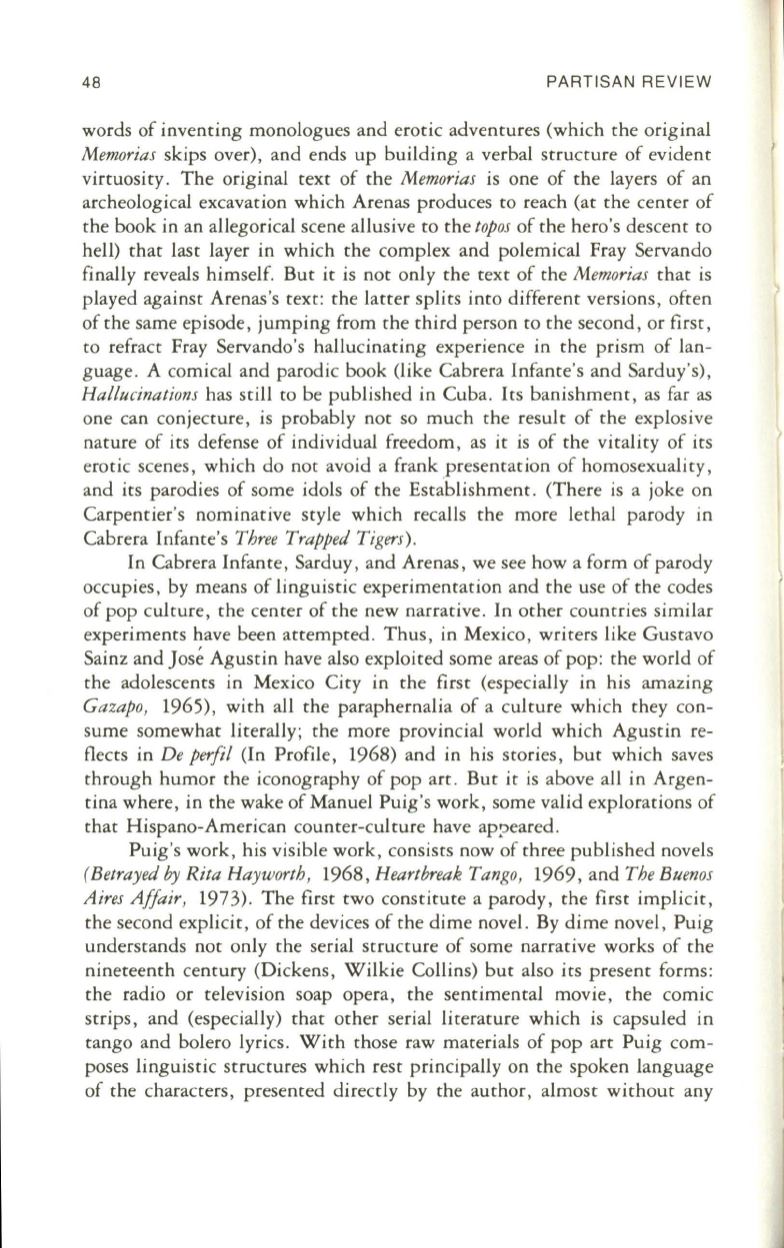
48
PARTISAN REVIEW
words of inventing monologues and erotic adventures (which the original
Memorias
skips over), and ends up building a verbal structure of evident
virtuosity. The original text of the
Memorias
is one of the layers of an
archeological excavation which Arenas produces ro reach (at the center of
the book in an allegorical scene allusive to the
topos
of the hero's descent to
hell) that last layer in which the complex and polemical Fray Servando
finally reveals himself. But it is not only the text of the
Memorias
that is
played against Arenas 's text: the latter splits into different versions, often
of the same episode, jumping from the third person to the second, or first,
to refract Fray Servando's hallucinating experience in the prism of lan–
guage . A comical and parodic book (like Cabrera Infante's and Sarduy's),
Hallucinations
has still
to
be published in Cuba. Its banishment, as far as
one can conjecture, is probably not so much the result of the explosive
nature of its defense of individual freedom, as it is of the vitality of its
erotic scenes, which do not avoid a frank presentation of homosexuality,
and its parodies of some idols of the
Est~blishment.
(There is a joke on
Carpentier's nominative style which recalls the more lethal parody in
Cabrera Infante's
Three Trapped Tigers).
In Cabrera Infante, Sarduy, and Arenas, we see how a form of parody
occupies, by means of linguistic experimentation and the use of the codes
of pop culture, the center of the new narrative. In other countries similar
experiments have been attempted . Thus, in Mexico, writers like Gustavo
Sainz and Jose Agustin have also exploited some areas of pop: the world of
the adolescents in Mexico City in the first (especially in his amazing
Gazapo,
1965), with all the paraphernalia of a culture which they con–
sume somewhat literally; the more provincial world which Agustin re–
flects in
De perfil
(In Profile, 1968) and in his stories, but which saves
through humor the iconography of pop art. But it is above all in Argen–
tina where, in the wake of Manuel Puig's work, some valid explorations of
that Hispano-American counter-culture have ap.?eared.
Puig's work, his visible work, consists now of three published novels
(Betrayed
by
Rita Hayworth,
1968,
Heartbreak Tango,
1969, and
The Buenos
Aires Affair,
1973). The first two constitute a parody, the first implicit,
the second explicit, of the devices of the dime novel. By dime novel, Puig
understands not only the serial structure of some narrative works of the
nineteenth century (Dickens, Wilkie Collins) but also its present forms :
the radio or television soap opera, the sentimental movie, the comic
strips, and (especially) that other serial literature which is capsuled in
tango and bolero lyrics. With those raw materials of pop art Puig com–
poses linguistic structures which rest principally on the spoken language
of the characters, presented directly by the author, almost without any


